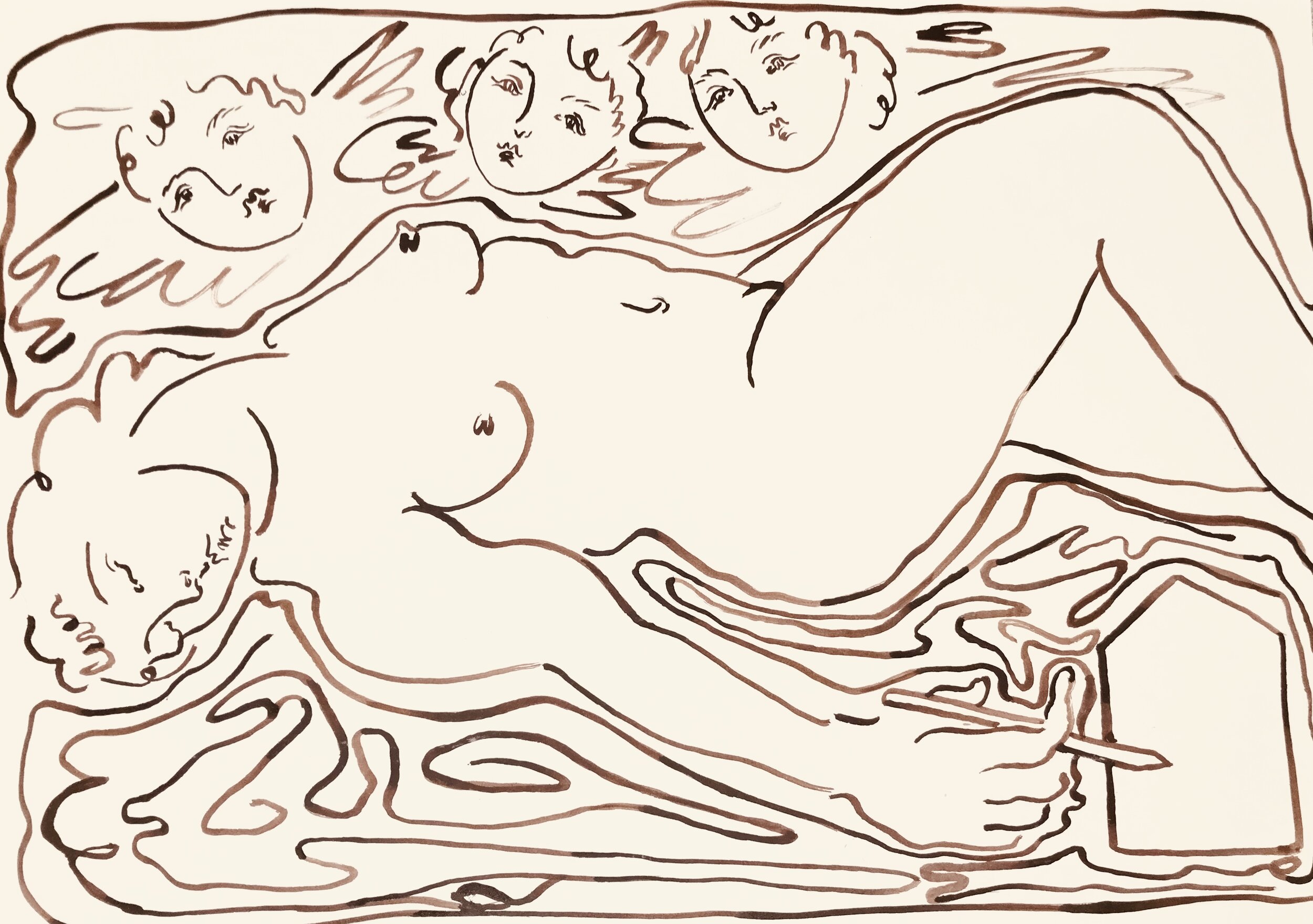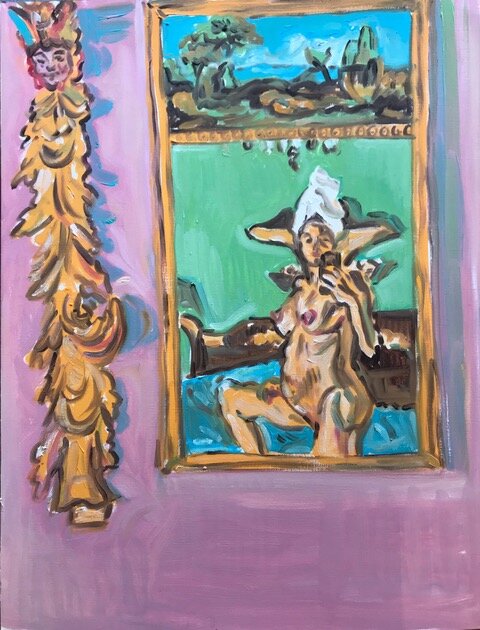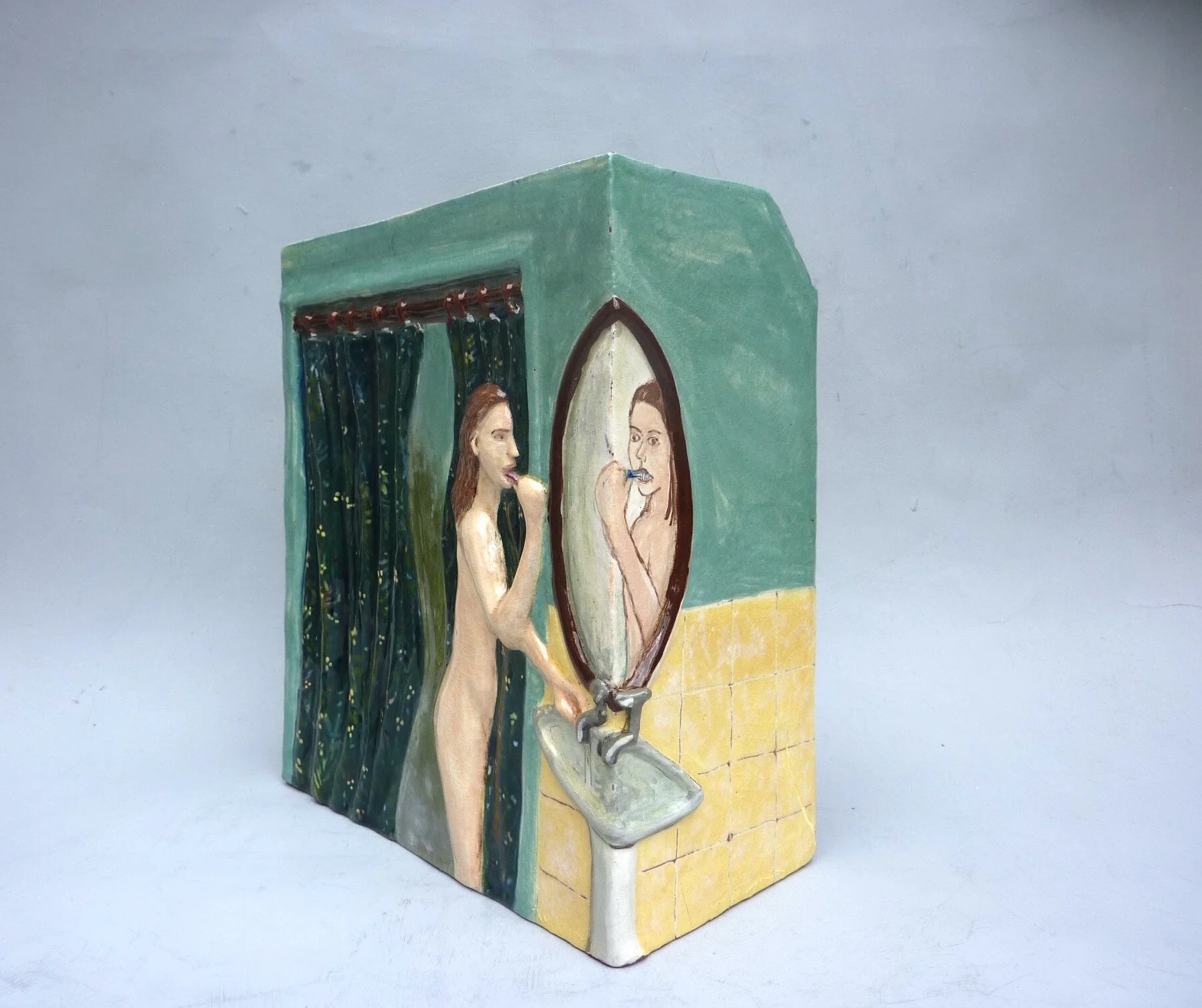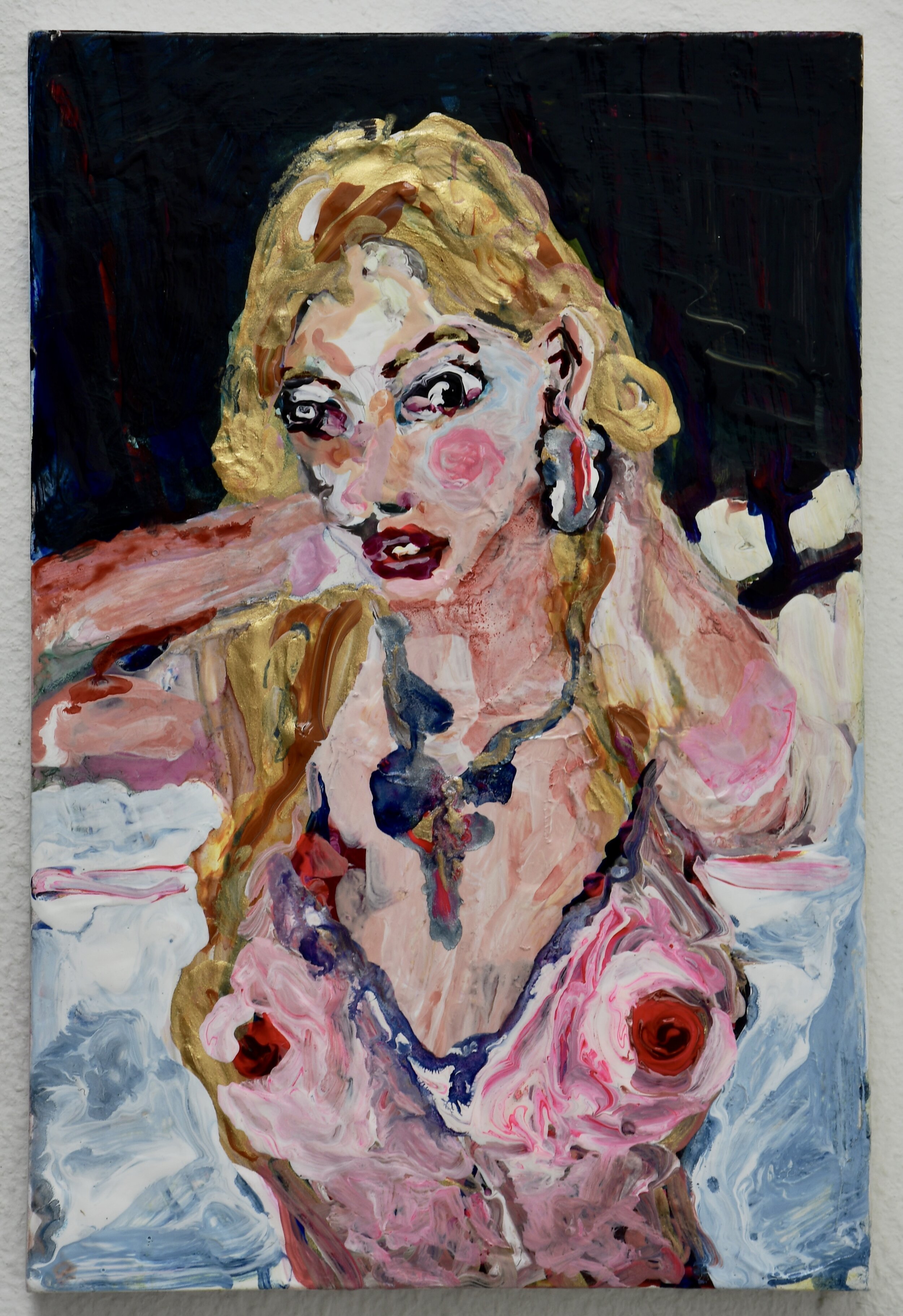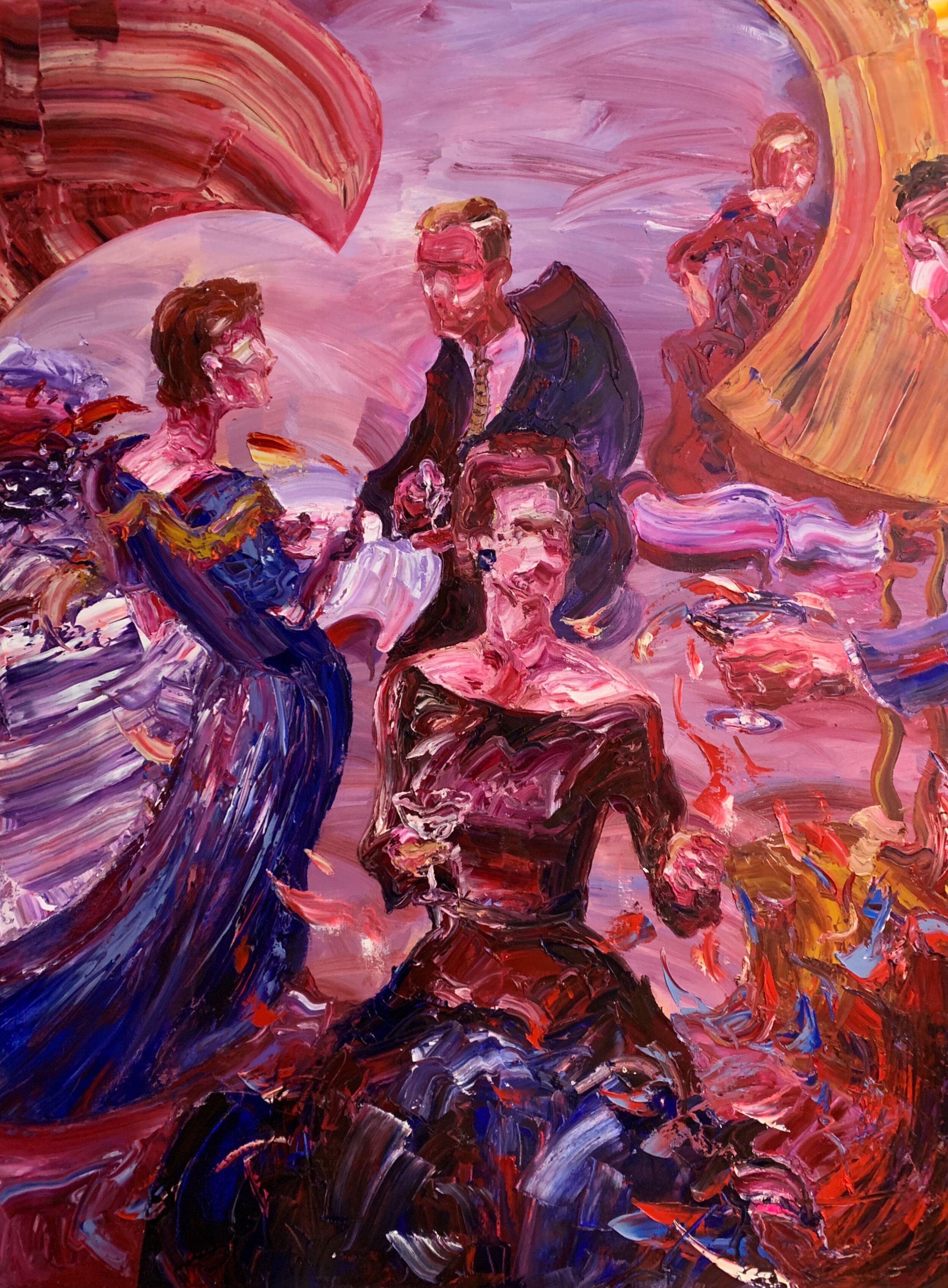
Joséphine-May Bailey is pleased to present Domesticity and the Feminine a group exhibition in support of WOMEN’S AID featuring twenty four women artists.
Associating the feminine with the interior and the domestic is a common (and outdated) way of conceptualising femininity. The artists included in this exhibition explore the complex rituals and moods of domestic experience as women, especially in the wake of COVID-19.
Intentionally continuing a dialogue with the artistic and feminist foremothers of the 1970s, the contemporary artists in Domesticity and the Feminine recast conventional ideas about women through sculpture, painting and installation.
Artists such as Marcelina Amelia, Ruby Bateman and Rafaela de Ascanio conceptualise the female body as the archetypal form of home, since it is humankind’s first dwelling. Images of the maternal body as a space that is nurturing and powerful, yet also to some extent tethered to the domestic environment. By contrast, works by Lindsey McLean directly question the historical representation of femininity and women in painting. McLean’s chosen surfaces are found-objects that directly address the centuries of unpaid domestic labour of women, we can almost imagine the hands of women scrubbing at the washing board, and burning their hands on an iron. Karen Tronel and Nicole Clark, through their use of needlework and fabric respectively similarly reference the historical labour of women, whilst also hinting to the issue of gendering ‘craft’.
Anna Pogduz, presents, in her own words, “modern and monstrous women”, who are full of hyperbole and languish. Pogduz’s women are an embodiment of consumerism, revealing in a similar way to McLean, a subtle criticism of capitalist society. The reference to consumerist culture, patriarchy and captialism is also felt strongly in works by Rhiannon Salisbury who deliberately works with found imagery from aspiration fashion and lifestyle magazines. Salisbury exaggerates and distorts these images, much like Pogduz, to expose the dystopian perception of the capitalist dream.
Intimacy is a thematic vein that runs through many of the artists works, specifically Harriet Gillett, Elizabeth Power, Henrietta MacPhee, Cecilia Reeve and Catherine Lette. Intertwined with the notion of the domestic and domesticity, is a sense of solitude, quiet intimacy, and privacy. These artists present the home, or the domestic, as an extension of their own bodies, melding together ‘normal’ homely rituals and the body. Images of hands holding each other or scenes of comfort and normality take on a new meaning.
The viewer is provided a unique perspective into the lives of those depicted - these works serve as a mirror, allowing the viewer to see their own domestic experience reflected back at them.
Most of the works included in this exhibition focus on women’s bodies - either directly or indirectly. This is no surprise given not only the theme, but also the art historical backdrop to the representation of the female nude. Anna Woodward casts this historical norm firmly into the present day, by abstracting classical depictions of the female nude. Orla Murray’s work ‘Hot Milk’, much like Salibury and Pogduz, draws on commercial images of women, emphasising the dichotomy tmy between erotic and softness.
Anna Choutova presents a diptych of portraits showing two women seated looking directly at the viewer. The gaze is met, acknowledged and rejected. These women are in control of their own narrative, powerfully seated and demanding respect. Helena Cardow’s portrait is one that whilst still seeming in control, comments more directly on the complex dynamics of race, gender and sexuality - both these artists encourage the viewer to question the power dynamics inherent in the act of ‘looking’
Works by Alexandra Searle and Grace Mattingly present differing works that both comment on the playfulness that can go hand-in-hand with explorations of gender identity. The phallic references of Searle’s installation sculpture and the barbie-esque shoe that dominates Mattingly’s canvas both explore the intersection between the erotic and sometimes humourous element of what it is to indeed be ‘feminine’.
Fantasy and escapism from the domestic is a uniting concept through the works of Carolina Aguirre, Kate Burling, Ming Ying, Jessie Stevenson and Olivia Mundy. Colour erupts from both Ying’s and Stevenson’s work, which through completely different perspectives transport the viewer into a completely new realm.
Domesticity and the Feminine unites the practices of differing women artists to present a variety of perspectives on a contentious and relevant topic. The exhibition runs from the 22nd of May till the 22nd of June. To enquire, please email josephinemaybailey@gmail.com or fill the form below.Elephant Magazine Article on “Domesticity and the Feminine” - https://elephant.art/redrawing-the-borders-between-the-domestic-and-the-feminine-03062021/

Marcelina Amelia, Figure With Cabbage Breasts, 2021 Acrylic on Canvas, 90 x 70cm, £2200
Anna Pogduz, Me in a Hot Bubble Bath, Acrylic and Gold Leaf on Canvas, 80 x 80 cm, £2000
Lindsey McLean I am the Fire I am the Witch Oil on Wooden Ironing Board 107 x 30 cm £1,200
Carolina Aguirre La Fiesta, 2021 Acrylic and Charcoal on Layered Paper 124 x 160cm £1100
Ruby Bateman, Mothers in Lockdown, 2021, Ink on Canvas, 59.4 x 84.1 cm, £350
Catherine Lette, Reclining Woman 2021, Acrylic on Cotton Canvas, 81 x 51 x 1.5 cm, £900
Rafaela de Ascanio, 21 Weeks - La Palma 2019, Oil on Paper, 50 x 65 cm, £700
Orla Murray, 'Hot Milk' 2020, Oil on Canvas, 90 x 70 cm, £1180
SOLD Marcelina Amelia, Swollen, 2021, Mixed Media on paper, 35 x 25 cm, £450
Lindsey McLean, Washer, Oil on Washer Board, 31 x 59 cm, £950
SOLD Jessie Stevenson, First Sweet Evening Yellow Study 3, 2021, Oil on Paper, 16.5 x 17.5 cm, £300
Olivia Mundy, Magma, 2021, Acrylic on Canvas, 120 x 169 cm, £1,200
Alexandra Searle, In the Pink, Glass, bismuth subsalicylate, 45 x 30 x 12cm, POA
Elizabeth Power, Bedroom Light Study 1, A3 work on Paper, £350
Henrietta MacPhee, Self Portrait, 2019, Glazed Ceramic, 25 x 22 x 11 cm, £950
Ruby Bateman, The Dream, 2021, Ink on Canvas, 59.4 x 84.1cm, £350 - SOLD
Rhiannon Salisbury, Gentlemen Prefer Blondes, 2021, Acrylic on Gesso Panel, 15 x 10 cm, £250 - SOLD
Carolina Aguirre, The Thief, 2021, Acrylic and Charcoal on Layered Paper, 55 x 62cm, £750
Anna Woodward, Is Fate Free from Divine Intervention?, 2021, Oil on Canvas, 100 x 100 cm, £1100
Louisa Clark, Untitled, 2019, Oil on Loose Linen, 37 x 37 cm, £250
Kate Burling, Mob Cap with Guy Ropes, Oil on Canvas, 60 x 90 cm, £1650
Jessie Stevenson, All the Wonders of Old, Study 1, 2021, Oil on Paper, 16.5 x 17.5 cm, £300
Rafaela de Ascanio, See No Evil, 2019, Glaze and Underglaze on Stoneware, 42 x 22 x 19cm, £800
Anna Choutova, Portrait of Andrea Gomis 2021 , Oil on Canvas, 140 x 90cm, Oil on Canvas, £1900
Anna Choutova, Self Portrait on a Good Day, 2021, Oil on Canvas, 140 x 90cm, £1900
Helena Cardow, Monochromatic, 2021, Oil on Canvas, 80 x 60 cm, £575
Cecilia Reeve, Hot and Soapy, 2021, Gouache on Watercolour Paper, 29.7 x 21 cm, £400
Olivia Mundy, The Fruits of the Clouds, 2021, Acrylic on Canvas, 110 x 120cm, £1000
Grace Mattingly, Two Shoes, 2021, Oil on Canvas, 36 x 40cm, £835
Catherine Lette, Pot Plant, 2021, Acrylic on Cotton Canvas, £500
Karen Tronel, Intercellular, Oil and Red Cotton Stitching on Layered Canvas, 109 x 109 cm, £1600
Ming Ying, The Moon Sinks Whilst Dancing Continues, 2021, Oil on Canvas, 90 x 120 cm, £6,500
Harriet Gillett, Waiting for Nothing, 2021, Watercolour on Khadi Rag, 38.5 x 42.5 cm, £450
Anna Woodward, The Palace of Alcinous, Gouache and Acrylic on A4 Khadi Paper, 21 x 29 cm, £230
